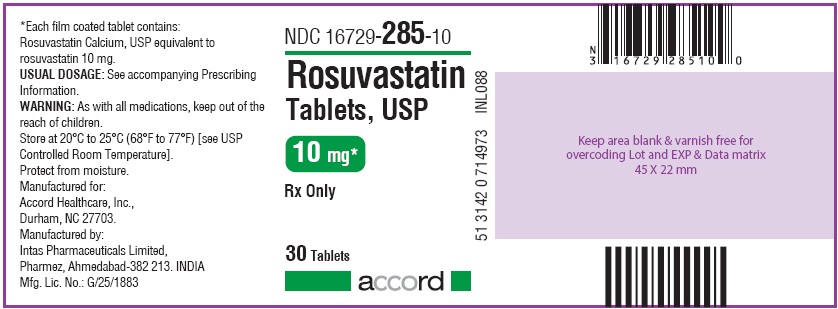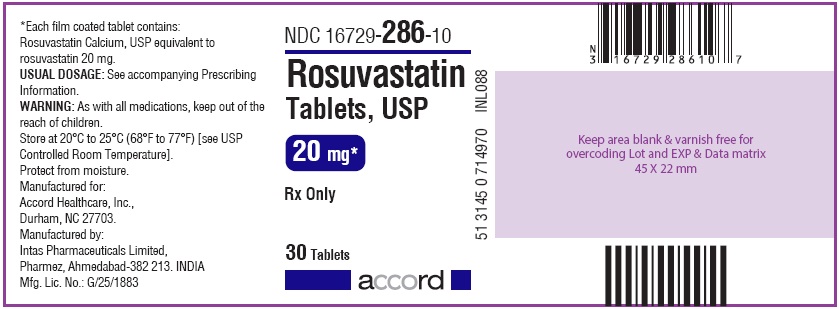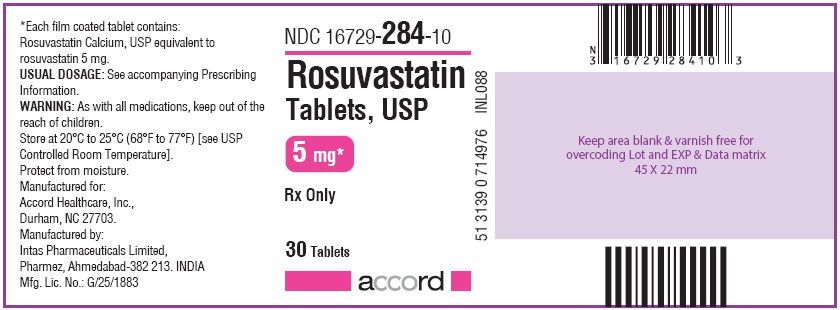Drug Catalog - Product Detail
ROSUVASTATIN CALCIUM 20MG TB 90CT
| NDC | Mfr | Size | Str | Form |
|---|---|---|---|---|
| 16729-0286-15 | ACCORD HEALTHCARE | 90 | 20MG | TABLET |
PACKAGE FILES





Generic Name
ROSUVASTATIN
Substance Name
ROSUVASTATIN CALCIUM
Product Type
HUMAN PRESCRIPTION DRUG
Route
ORAL
Application Number
ANDA206434
Description
11 DESCRIPTION Rosuvastatin calcium is a synthetic lipid-lowering agent for oral administration. The chemical name for rosuvastatin calcium is bis[(E)-7-[4-(4-fluorophenyl)-6-isopropyl-2-[methyl(methylsulfonyl)amino] pyrimidin-5-yl](3R,5S)-3,5-dihydroxyhept-6-enoic acid] calcium salt with the following structural formula: The empirical formula for rosuvastatin calcium is (C 22 H 27 FN 3 O 6 S) 2 Ca and the molecular weight is 1001.14. Rosuvastatin calcium, USP is a white amorphous powder that is sparingly soluble in water and methanol, and slightly soluble in ethanol. Rosuvastatin calcium, USP is a hydrophilic compound with a partition coefficient (octanol/water) of 0.13 at pH of 7.0. Rosuvastatin tablets, USP for oral administration contain 5, 10, 20, or 40 mg of rosuvastatin and the following inactive ingredients: For 5 mg: Each film coated tablet contains: microcrystalline cellulose, lactose monohydrate, anhydrous lactose, crospovidone, magnesium oxide, magnesium stearate, hypromellose, triacetin, titanium dioxide, and ferric oxide yellow. For 10, 20 and 40 mg: Each film coated tablet contains: microcrystalline cellulose, lactose monohydrate, anhydrous lactose, crospovidone, magnesium oxide, magnesium stearate, hypromellose, triacetin, titanium dioxide, FD & C yellow No. 6, FD & C red No. 40, and FD & C blue No.1. Rosuvastatin tablets, USP meet USP Dissolution Test 2. strucural formula
How Supplied
16 HOW SUPPLIED/STORAGE AND HANDLING Rosuvastatin tablets, USP are supplied as: NDC 16729-284: 5 mg. Yellow, round, biconvex, film-coated tablet, debossed “5” on one side and “FI” on other side; Bottle of 30 tablets with child-resistant closure NDC 16729-284-10 Bottle of 90 tablets with child-resistant closure NDC 16729-284-15 Bottle of 1000 tablets NDC 16729-284-17 NDC 16729-285: 10 mg. Pink, round, biconvex, film-coated tablet, debossed “10” on one side and “R” on other side; Bottle of 30 tablets with child-resistant closure NDC 16729-285-10 Bottle of 90 tablets with child-resistant closure NDC 16729-285-15 Bottle of 1000 tablets NDC 16729-285-17 NDC 16729-286: 20 mg. Pink, round, biconvex, film-coated tablet, debossed “20” on one side and “R” on other side; Bottle of 30 tablets with child-resistant closure NDC 16729-286-10 Bottle of 90 tablets with child-resistant closure NDC 16729-286-15 Bottle of 1000 tablets NDC 16729-286-17 NDC 16729-287: 40 mg. Pink, oval, biconvex, film-coated tablet, debossed “40” on one side and “R” on other side; Bottle of 30 tablets with child-resistant closure NDC 16729-287-10 Bottle of 90 tablets with child-resistant closure NDC 16729-287-15 Bottle of 1000 tablets NDC 16729-287-17 Storage Store at 20ºC to 25ºC (68ºF to 77ºF) [see USP Controlled Room Temperature]. Protect from moisture.
Indications & Usage
1 INDICATIONS AND USAGE Pediatric use information for patients 7 to 17 years of age is approved for AstraZeneca’s CRESTOR (rosuvastatin calcium) tablets. However, due to AstraZeneca’s marketing exclusivity rights, this drug product is not labeled with that pediatric information. Rosuvastatin tablets are an HMG Co‑A reductase inhibitor indicated for: adult patients with hypertriglyceridemia as an adjunct to diet (1.3) adult patients with primary dysbetalipoproteinemia (Type III hyperlipoproteinemia) as an adjunct to diet (1.4) adult patients with homozygous familial hypercholesterolemia (HoFH) to reduce LDL‑C, total-C, and ApoB (1.5) Limitations of use (1.8) : Rosuvastatin tablets have not been studied in Fredrickson Type I and V dyslipidemias. 1.3 Hypertriglyceridemia Rosuvastatin tablets are indicated as adjunctive therapy to diet for the treatment of adult patients with hypertriglyceridemia. 1.4 Primary Dysbetalipoproteinemia (Type III Hyperlipoproteinemia) Rosuvastatin tablets are indicated as an adjunct to diet for the treatment of adult patients with primary dysbetalipoproteinemia (Type III Hyperlipoproteinemia). 1.5 Adult Patients with Homozygous Familial Hypercholesterolemia Rosuvastatin tablets are indicated as adjunctive therapy to other lipid-lowering treatments (e.g., LDL apheresis) or alone if such treatments are unavailable to reduce LDL-C, Total-C, and ApoB in adult patients with homozygous familial hypercholesterolemia. 1.8 Limitations of Use Rosuvastatin tablets have not been studied in Fredrickson Type I and V dyslipidemias.
Dosage and Administration
2 DOSAGE AND ADMINISTRATION Rosuvastatin tablets can be taken with or without food, at any time of day. (2.1) Dose range: 5 to 40 mg once daily. Use 40 mg dose only for patients not reaching LDL‑C goal with 20 mg. (2.1) Adult HoFH: Starting dose 20 mg/day (2.1) 2.1 General Dosing Information The dose range for rosuvastatin tablet in adults is 5 to 40 mg orally once daily. The usual starting dose is 10 to 20 mg once daily. The usual starting dose in adult patients with homozygous familial hypercholesterolemia is 20 mg once daily. The maximum rosuvastatin tablet dose of 40 mg should be used only for those patients who have not achieved their LDL-C goal utilizing the 20 mg dose [ see Warnings and Precautions (5.1) ]. Rosuvastatin tablets can be administered as a single dose at any time of day, with or without food. The tablet should be swallowed whole. When initiating rosuvastatin therapy or switching from another HMG-CoA reductase inhibitor therapy, the appropriate rosuvastatin tablets starting dose should first be utilized, and only then titrated according to the patient’s response and individualized goal of therapy. After initiation or upon titration of rosuvastatin, lipid levels should be analyzed within 2 to 4 weeks and the dosage adjusted accordingly. Pediatric use information for patients 7 to 17 years of age is approved for AstraZeneca’s CRESTOR (rosuvastatin calcium) tablets. However, due to AstraZeneca’s marketing exclusivity rights, this drug product is not labeled with that pediatric information. 2.3 Dosing in Asian Patients In Asian patients, consider initiation of rosuvastatin therapy with 5 mg once daily due to increased rosuvastatin plasma concentrations. The increased systemic exposure should be taken into consideration when treating Asian patients not adequately controlled at doses up to 20 mg/day [ see Use in Specific Populations (8.8) and Clinical Pharmacology (12.3) ]. 2.4 Use with Concomitant Therapy Patients taking cyclosporine and darolutamide The dose of rosuvastatin tablets should not exceed 5 mg once daily [ see Warnings and Precautions (5.1) , Drug Interactions (7.1) , Drug Interactions (7.4) and Clinical Pharmacology (12.3) ]. Patients taking gemfibrozil Avoid concomitant use of rosuvastatin with gemfibrozil. If concomitant use cannot be avoided, initiate rosuvastatin tablets at 5 mg once daily. The dose of rosuvastatin tablets should not exceed 10 mg once daily [ see Warnings and Precautions (5.1), Drug Interactions (7.2) and Clinical Pharmacology (12.3) ]. Patients taking regorafenib Concomitant use of rosuvastatin tablets and regorafenib, the dose of rosuvastatin tablets should not exceed 10 mg once daily [ see Warnings and Precautions (5.1), Drug Interactions (7.5) and Clinical Pharmacology (12.3) ]. Patients taking atazanavir and ritonavir, lopinavir and ritonavir, simeprevir or combination of dasabuvir/ombitasvir/paritaprevir/ritonavir, elbasvir/grazoprevir, sofosbuvir/velpatasvir and glecaprevir/pibrentasvir Initiate rosuvastatin therapy with 5 mg once daily. The dose of rosuvastatin tablets should not exceed 10 mg once daily [ see Warnings and Precautions (5.1) , Drug Interactions (7.3), and Clinical Pharmacology (12.3) ]. 2.5 Dosing in Patients with Severe Renal Impairment For patients with severe renal impairment (CL cr <30 mL/min/1.73 m 2 ) not on hemodialysis, dosing of rosuvastatin tablets should be started at 5 mg once daily and not exceed 10 mg once daily [ see Use in Specific Populations (8.6) and Clinical Pharmacology (12.3) ].
